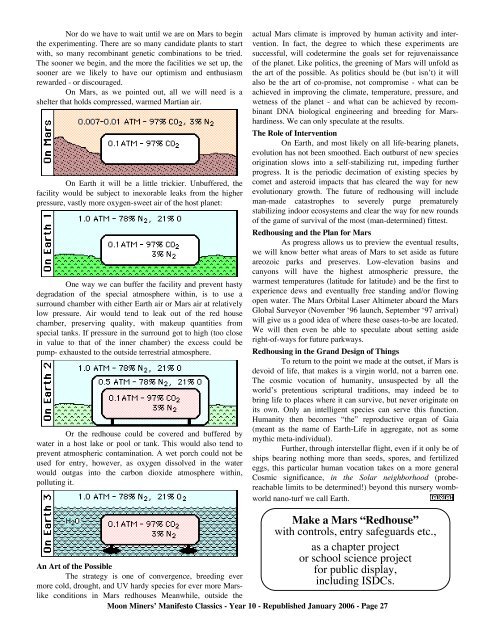MMM Classics Year 10: MMM #s 91-100 - Moon Society
MMM Classics Year 10: MMM #s 91-100 - Moon Society
MMM Classics Year 10: MMM #s 91-100 - Moon Society
You also want an ePaper? Increase the reach of your titles
YUMPU automatically turns print PDFs into web optimized ePapers that Google loves.
Nor do we have to wait until we are on Mars to begin<br />
the experimenting. There are so many candidate plants to start<br />
with, so many recombinant genetic combinations to be tried.<br />
The sooner we begin, and the more the facilities we set up, the<br />
sooner are we likely to have our optimism and enthusiasm<br />
rewarded - or discouraged.<br />
On Mars, as we pointed out, all we will need is a<br />
shelter that holds compressed, warmed Martian air.<br />
On Earth it will be a little trickier. Unbuffered, the<br />
facility would be subject to inexorable leaks from the higher<br />
pressure, vastly more oxygen-sweet air of the host planet:<br />
One way we can buffer the facility and prevent hasty<br />
degradation of the special atmosphere within, is to use a<br />
surround chamber with either Earth air or Mars air at relatively<br />
low pressure. Air would tend to leak out of the red house<br />
chamber, preserving quality, with makeup quantities from<br />
special tanks. If pressure in the surround got to high (too close<br />
in value to that of the inner chamber) the excess could be<br />
pump- exhausted to the outside terrestrial atmosphere.<br />
Or the redhouse could be covered and buffered by<br />
water in a host lake or pool or tank. This would also tend to<br />
prevent atmospheric contamination. A wet porch could not be<br />
used for entry, however, as oxygen dissolved in the water<br />
would outgas into the carbon dioxide atmosphere within,<br />
polluting it.<br />
An Art of the Possible<br />
The strategy is one of convergence, breeding ever<br />
more cold, drought, and UV hardy species for ever more Marslike<br />
conditions in Mars redhouses Meanwhile, outside the<br />
actual Mars climate is improved by human activity and intervention.<br />
In fact, the degree to which these experiments are<br />
successful, will codetermine the goals set for rejuvenaissance<br />
of the planet. Like politics, the greening of Mars will unfold as<br />
the art of the possible. As politics should be (but isn’t) it will<br />
also be the art of co-promise, not compromise - what can be<br />
achieved in improving the climate, temperature, pressure, and<br />
wetness of the planet - and what can be achieved by recombinant<br />
DNA biological engineering and breeding for Marshardiness.<br />
We can only speculate at the results.<br />
The Role of Intervention<br />
On Earth, and most likely on all life-bearing planets,<br />
evolution has not been smoothed. Each outburst of new species<br />
origination slows into a self-stabilizing rut, impeding further<br />
progress. It is the periodic decimation of existing species by<br />
comet and asteroid impacts that has cleared the way for new<br />
evolutionary growth. The future of redhousing will include<br />
man-made catastrophes to severely purge prematurely<br />
stabilizing indoor ecosystems and clear the way for new rounds<br />
of the game of survival of the most (man-determined) fittest.<br />
Redhousing and the Plan for Mars<br />
As progress allows us to preview the eventual results,<br />
we will know better what areas of Mars to set aside as future<br />
areozoic parks and preserves. Low-elevation basins and<br />
canyons will have the highest atmospheric pressure, the<br />
warmest temperatures (latitude for latitude) and be the first to<br />
experience dews and eventually free standing and/or flowing<br />
open water. The Mars Orbital Laser Altimeter aboard the Mars<br />
Global Surveyor (November ‘96 launch, September ‘97 arrival)<br />
will give us a good idea of where these oases-to-be are located.<br />
We will then even be able to speculate about setting aside<br />
right-of-ways for future parkways.<br />
Redhousing in the Grand Design of Things<br />
To return to the point we made at the outset, if Mars is<br />
devoid of life, that makes is a virgin world, not a barren one.<br />
The cosmic vocation of humanity, unsuspected by all the<br />
world’s pretentious scriptural traditions, may indeed be to<br />
bring life to places where it can survive, but never originate on<br />
its own. Only an intelligent species can serve this function.<br />
Humanity then becomes “the” reproductive organ of Gaia<br />
(meant as the name of Earth-Life in aggregate, not as some<br />
mythic meta-individual).<br />
Further, through interstellar flight, even if it only be of<br />
ships bearing nothing more than seeds, spores, and fertilized<br />
eggs, this particular human vocation takes on a more general<br />
Cosmic significance, in the Solar neighborhood (probereachable<br />
limits to be determined!) beyond this nursery wombworld<br />
nano-turf we call Earth.<br />
Make a Mars “Redhouse”<br />
with controls, entry safeguards etc.,<br />
as a chapter project<br />
or school science project<br />
for public display,<br />
including ISDCs.<br />
<strong>Moon</strong> Miners’ Manifesto <strong>Classics</strong> - <strong>Year</strong> <strong>10</strong> - Republished January 2006 - Page 27















